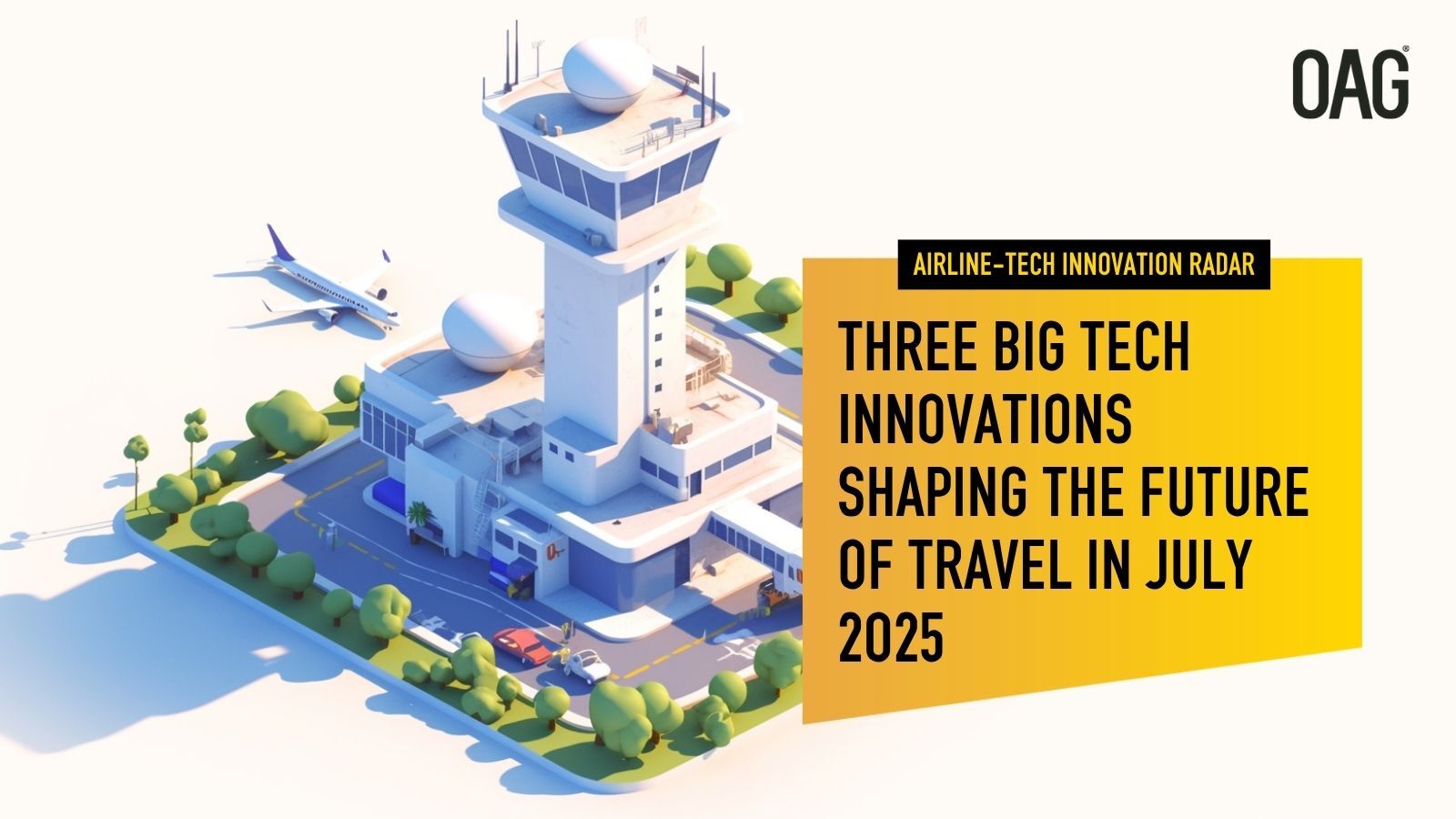Big Tech is quietly rewriting the front end of the travel experience.
Historically, airlines and airports have owned the key touchpoints between passengers and their journey, including check-in, boarding passes, flight updates, and baggage tracking. But that control is starting to shift.
- In July, some of the most noteworthy innovations in air travel didn’t come from within the industry, but from consumer tech giants.
- Big Tech is moving deeper into travel, embedding itself at critical moments in the passenger experience, as you’ll see in this edition.
The implications are profound.
As user attention and expectations are increasingly shaped by these external platforms, airlines may no longer be able to define what a “good” customer experience looks like.
Instead, they’ll be expected to operate within the design logic and interface rules of iPhones, Apple Wallets, and AI assistants.
In this month’s Innovation Radar, we highlight three standout moves that signal this shift.
Together, they paint a clear picture: the future of the travel user experience may be built on someone else’s platform.
Innovation #1: Apple Brings TSA-Approved Digital Passports to the Wallet
After years of discussing “digital identity” in travel, we’re finally seeing a concrete step forward, this time led by one of the world’s most influential tech players. Apple recently announced that U.S. iPhone users will soon be able to add their passports to their Apple Wallets, creating a TSA-approved digital ID usable at domestic airport security checkpoints.
It’s a move many are calling a milestone in modernizing the travel experience.
What exactly is happening?
With the rollout of this feature, travelers can now store and present their passports digitally, much like a boarding pass.
Here is how the process works:
- Users upload passport details into their Apple Wallets.
- TSA scans and verifies the digital IDs at security checkpoints.
- No need to carry or hand over a physical document.
This initiative builds on Apple’s earlier support for digital driver’s licenses in select states. But, by enabling digital passports, Apple is now pushing deeper into the heart of the travel identity stack.

Why does this innovation stand out?
Digital identity has long been viewed as a key unlock for seamless travel, but its adoption has not kept pace with the hype, especially given the complex combination of regulatory requirements, safety concerns, and the need for multi-stakeholder cooperation. Apple’s announcement appears to be a breakthrough. Not only does it simplify airport security processes and reduce document-handling friction, but it also aligns with the upcoming enforcement of Real ID regulations, offering a modern, secure alternative to outdated ID workflows.
Just as importantly, it signals the growing role of consumer tech giants in shaping the infrastructure of Travel Tech itself. By embedding government-recognized ID functions into its ecosystem, Apple is quietly becoming a central player in how we move through airports – and eventually, across borders.
Last but not least, it offers a glimpse into a paperless, biometric-driven travel future where your phone may serve as your passport, boarding pass, and central travel checkpoint, all in one.

Innovation #2: Apple (and Air Canada) Turn the Boarding Pass into a Travel Command Center
Sticking with Apple for a second travel-relevant innovation. This one also has significant implications for enhancing the passenger experience.
Shortly after announcing its digital passport, Apple unveiled a redesigned boarding pass experience as part of its refreshed Apple Wallet at the annual WWDC developer conference. The update turns the humble boarding pass into a centralized travel hub, offering live flight updates, terminal maps, baggage tracking, and more, all within the iPhone lock screen.
The headline for June?
Air Canada has emerged as one of the first airlines globally (and the very first non-U.S. carrier) to support this new feature, joining a lineup that includes Delta, United, JetBlue, and others. Once again, Air Canada reaffirms its position as an early adopter of passenger-centric digital innovation.
What exactly is new?
With the updated Apple Wallet, your boarding pass becomes much more than a scannable QR code. It now enables:
- Live flight updates that appear directly on your lock screen.
- One-tap shortcuts to share flight status with friends, open Apple Maps for terminal directions, or access “Find My” to track checked bags.
- Integrated terminal maps that visualize gate locations without switching between apps.
The result: no need to recheck airline apps or web portals. All your travel info stays front and center on your screen, turning the iPhone into a personal control tower for your entire air travel journey, from check-in to baggage claim.

Why does this innovation stand out?
First, it reduces passenger stress by providing real-time updates and direct access to critical journey tools, all inside the native Apple ecosystem. The tighter integration offers a smoother mobile experience than many airline apps have ever managed to deliver, and it comes without the friction of logins, pop-ups, or buried menus.
Second, this raises the bar for what travelers expect from digital touchpoints. Airlines like Air Canada that integrate early not only stand out for user experience, but also for embracing a shift where the travel app is no longer the airline’s, but Apple’s.
Third, this reinforces a broader trend: Big Tech is quietly becoming the backbone of modern travel infrastructure. From baggage tracking via AirTags to digital passports and now intelligent boarding passes, Apple is methodically embedding itself into the operational and emotional layers of the travel journey. While airlines and airports have struggled to develop similarly elegant tools in-house, partnerships with platforms like Apple might prove more effective (and scalable) than attempting to do so independently.
As Apple builds out this digital layer of the passenger experience, the question for airlines isn’t whether to integrate, but how soon.

Innovation #3: Iberia Becomes First Airline to Launch AI Assistant on ChatGPT
Innovation #3 doesn’t come from Apple, but it’s yet another example of an airline looking beyond the travel industry, again to a big tech player, to shape the next evolution of customer experience.
Iberia just became the first airline to launch a dedicated AI assistant directly on OpenAI’s ChatGPT platform, marking a significant shift in how and where airlines can engage with travelers. The assistant lives inside the GPT Store and is designed to help users explore destinations, search for flights with flexible dates, plan multi-city trips, and even optimize based on budget, before handing over the results for booking directly via Iberia’s systems.
So why does this stand out amid the current wave of airline-AI activity we explored in our May and June editions?
It’s the first real example of an airline embedding itself natively into a major consumer AI platform, rather than building its own branded chatbot experience on its website or app, which often serves as just a front-end “wrapper” around the same underlying models, such as ChatGPT.
- While most airline AI strategies have focused on building standalone chat interfaces on their own websites or apps, Iberia is betting on the idea that travelers will increasingly start their journey within general-purpose AI assistants like ChatGPT.
- And by being present there early, the airline positions itself at the top of that funnel.
- In other words, it’s one of the first examples of a travel provider recognizing that travel discovery, planning, and booking (especially among younger and more digitally savvy travelers) may no longer occur on their own channels.

That said, there are still open questions.
Access is currently limited to the GPT Store, which, at least for now, isn’t the first place average airline passengers would think to go when planning a trip.
And that raises a strategic dilemma: Will Iberia actively promote this channel, potentially cannibalizing traffic from its own website?
Or is this more of a test bed for future AI integrations?
Either way, the launch is notable. It signals a world in which AI assistants may soon serve as the new home screen for travel discovery, replacing the search bar and possibly even airline websites as the starting point of the traveler journey.

Stay tuned for the next edition of Airline-Tech Innovation Radar. In the meantime, discover more about the Future of Travel here.



